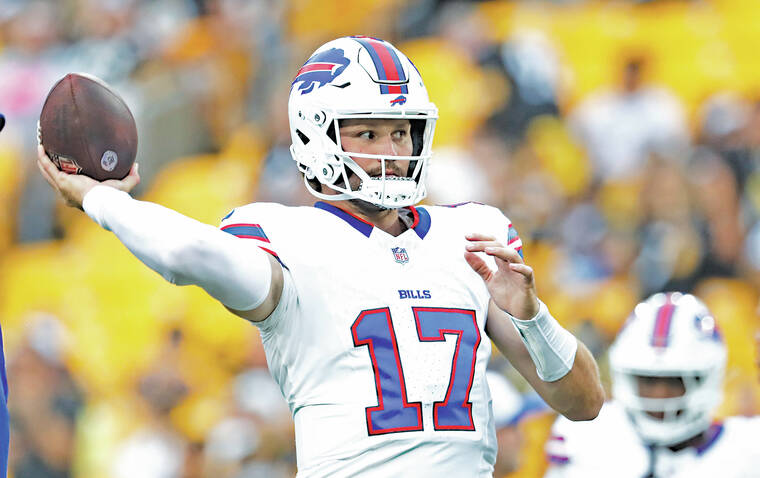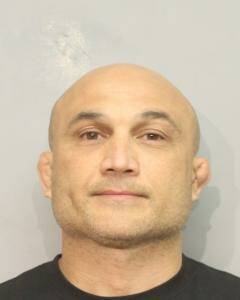We know more about quarterbacks’ arms than ever. Can NFL teams take advantage?
When Buffalo Bills quarterback Josh Allen comes across video of himself throwing passes for the University of Wyoming, he swears he does not recognize that guy.
“It’s night and day in terms of the type of thrower I am,” Allen said this summer. “Where I held the ball, where I released the ball — it looks like a different guy.”
ADVERTISING
Allen, like many other NFL quarterbacks, spends time each offseason tweaking his throwing motion, “just trying to be as efficient as possible,” he said. And efficiency is the specialty of biomechanics experts such as Chris Hess, the founder of the 3D motion analysis company Biometrek.
A quarterback is a “rotational athlete,” someone who rotates the body to throw, swing or hit. Hess and other specialists focus on the kinetic sequence, the transfer of energy during that rotation from the base of the body up through the arm.
An efficient thrower’s accuracy increases, biomechanists say, because energy travels in the correct sequence: from legs to pelvis to torso to arm, with each reaching peak rotational velocity as the next begins. More efficient throwers also put less stress on their arms over time because the body properly produces and transfers the energy required to throw.
“Accuracy isn’t voodoo,” Hess likes to say. “It’s biomechanical science.”
Allen has worked with Hess and his motion-capture software since 2020 and believes this has helped make him a more accurate thrower. Allen’s completion percentage jumped from 52.8 and 58.8 in 2018 and 2019 to 69.2% in 2020 and has not dipped below 63% since (even while playing through a partially torn ulnar collateral ligament in his right elbow in 2022).
More and more NFL quarterbacks rely on independent professionals like Hess to incorporate biomechanics and its technology into offseason training. Young stars like Allen, C.J. Stroud, Caleb Williams, Anthony Richardson and Brock Purdy have consulted with Hess to gather data that tells them how efficiently they throw using motion-capture technology.
After collecting and interpreting the data, Hess collaborates with physical therapists such as Tom Gormley to help players make body adjustments, while private quarterbacks coaches such as Will Hewlett, Jordan Palmer and Adam Dedeaux fine-tune mechanics and technique.
“It’s the most important position in all of sports, so you’re constantly evolving, trying to find ways to get mental reps, physical reps, without overdoing it,” general manager Brandon Beane of the Bills said. “There is so much invested in that position that you are always looking for any area to improve to give your guys even the slightest advantage.”
Each spring, Hess travels the country to put quarterbacks through his motion capture programming at the request of their private coaches and occasionally NFL teams. His equipment uses high-resolution cameras to track movement rather than attaching sensors to the player.
Streams of data emerge as the quarterback’s movement is translated by a computer into speed and energy outputs from every part of his body at each millisecond of every throw. Hess organizes the data into digestible pieces, including graphs and a visual display of the quarterback’s body as he throws — a skeleton frame with flashing colors that represent his energy transfer.
Hess and the physical therapists and private quarterbacks coaches he works with are not looking for massive issues. They emphasize the tiniest adjustments that can build the most efficient throwing motions possible.
“If you’re calling me, you’re ready for some granular information,” Hess said.
Much of the science informing Hess and others comes from over a decade of research and application of biomechanics in baseball and golf.
“Baseball is pretty much light-years ahead of the NFL as far as the ability to integrate sports science and also be data-driven,” said Emily Ferree, a physical therapist, biomechanist and movement specialist.
Baseball was an early investor in biomechanical application. Pitchers may use different types of throws, but the ball is always thrown a specific distance from a specific spot on the field.
“There is a very repeatable, very controllable movement that you can test and measure that is almost identical to the performance environment,” Ferree said.
A quarterback, on the other hand, can go into a play with a specific plan for his throw, but anything can happen after the snap. What are his body and arm doing when he is scrambling away from pressure or opting to throw a sidearm pass while on the move?
Biomechanics-specific motion capture technology has also proved useful in injury prevention and recovery. Ferree often sees quarterbacks try to protect their elbow as they return to throwing after an arm surgery. Their rotation changes, which has a ripple effect on the rest of the body.
Under Tyler Williams, the Minnesota Vikings’ vice president for player health and performance, the team accumulates data in as real a football environment as possible and studies the results over a long time. The team puts accelerometers in its practice footballs to measure changes in velocity, rotation and distance. They match those changes with movement trackers that assess energy output and stress on the body and parse this in combination with motion capture software and practice film.
The idea is to see what patterns might emerge regarding how players expend energy, the effect of certain movements and drills on the body and more.
“You’re building a picture with puzzle pieces,” Williams said. “In 1985, we were using the little kid puzzles that had eight pieces.” He added, “Now, we’re probably playing with a picture that is, like, a 500-piece puzzle.”
Like the Vikings, the Los Angeles Rams’ sports science department — once led by Williams and now by Trent Frey, who spent the past six years in a similar role with the NHL’s Los Angeles Kings — places sensors in the practice footballs. The Rams also collect movement tracking data for the entire roster and can quantify energy output per movement, which helps when building workload management plans for players.
Frey and the Rams’ medical and strength and conditioning staff then work with coaches to script out practices and weight room periods. The idea is to get every player as individualized a plan as possible while keeping a team atmosphere intact.
It was not so long ago, said the Rams’ director of strength and conditioning, Justin Lovett, that NFL quarterbacks protested getting pulled off the group weight training session in the interest of more specialized training. “The coaches and the quarterbacks would say, ‘I need my guys to see us work,’ ” Lovett said.
When Hess works with quarterbacks, he runs them through a final motion capture session right before organized team activities, and the player’s team receives the results. From there, a specialist can explain what adjustments were made, what warm-up and recovery exercises were implemented — and show why using Hess’ data.
Lovett believes the private sector has gotten so advanced that it can give an open-minded team an edge in building out its quarterback’s in-season training plan. External specialists and the quarterbacks they work with in the offseason have more information about a thrower’s arm than ever.
As investments into the position increase by millions of dollars each year, figuring out how to best tap into that information year-round might be NFL teams’ next advantage.





